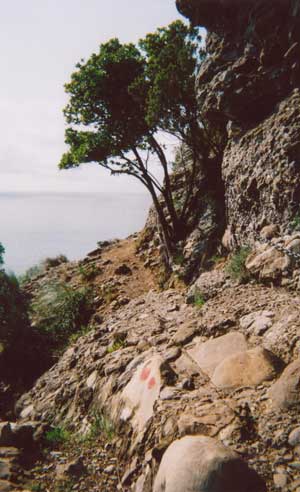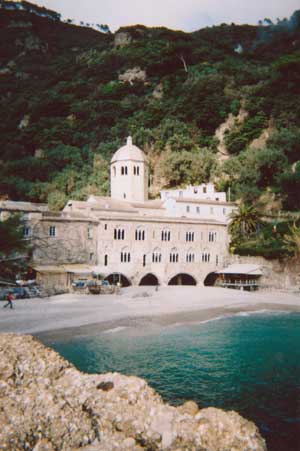San Fruttuoso – also known as San Fruttuoso di Camogli – is neither port nor resort. Not much more than an indentation along a mountainous coastline, accessible only from the sea or on foot. But it has two powerful attractions. One is an ancient Benedictine monastery and the other the Christ of the Abyss. The monastery is a lovely stone building with a small dome, which straddles the beach. Parts are medieval, some Romanesque, and the burial vaults of the aristocratic Doria family of Genoa are here. Until nature decided to throw up a beach in quite recent times, boats moored directly under the supporting arches of the monastery and could unload directly into the cellars. You can still walk beneath these arches and find the odd boat or two resting on the stones out of the weather. There is some exploring to do at San Fruttuoso, but the main monastery building and the sixteenth-century watch tower a short walk away (combined ticket for a few euros) are not always open: local information offices can supply the details.
The Christ of the Abyss (Cristo degli Abissi) is an above-life-size bronze statue a little way offshore and over fifty feet (15m) under the sea. You can see a replica in the church next to the monastery (no charge). It has only existed for a few decades, being commissioned after a drowning, but both the idea and the sculpture itself are deeply poignant. In season, and when boats are bringing visitors in, it’s possible to pay for a few minutes’ trip out from the shore and see the statue itself through a glass-bottomed contraption. Far down in the dim waters, Christ’s face and arms are raised towards the source of light. This has become something like a shrine to divers and a pilgrimage site. If San Fruttuoso were south of Rome rather than north we should be hearing of miracles. A copy has been placed in the warm waters of Florida.
There are several eating and drinking places at San Fruttuoso, although fewer and more improvised than one might imagine from local publicity. The little beach is just big enough to use as a ‘holiday’ beach and there’s scuba diving along the coast here. Behind the monastery rises a great slope covered mostly in Mediterranean pine and holm oak. You can also see old olive terraces which are being laboriously cleared of scrub and revived under an agriturismo programme.

Getting to San Fruttuoso
There’s no road. The nearest official parking is over an hour away at Portofino Vetta (which is not the same place as Portofino but nearer Camogli). From there the signposted walk to San Fruttuoso is fairly level and easy to begin with – as far as the path junction of Pietre Strette – but then falls sharply in zig-zags and steps down an old mule path in order to deal with a 1500-foot (450m) descent to sea level. It takes more time, nearer two hours, to make the uphill journey back. Alternatively, a powerful walker could use one or other of the even longer signposted routes from Camogli, Santa Margherita or Portofino.
In summer there are well-advertised boat trips, several times a day (hourly in midsummer), from Camogli to San Fruttuoso, and others from Portofino and Santa Margherita. A less reliable service runs daily from Camogli out of season too, but you shouldn’t expect to find very much in terms of tourist facilities at that time of year.
A reasonably fit visitor to the Portofino area, who is interested in both history and landscape, can happily spend the best part of a full day on a trip to San Fruttuoso, travelling one way on foot, the other by boat, spending a couple of hours at this unique spot.
Report and photographs by AH
